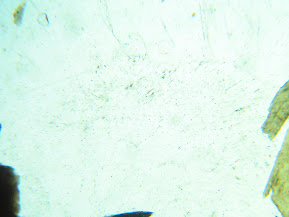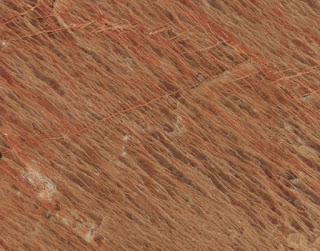Microcline is polymorphous with Orthoclase and Sanidine. The only difference between them is their crystal structure. Microcline crystallizes in the triclinic system, and Orthoclase and Sanidine crystallize in the monoclinic system. Crystals of Microcline are generally much larger than those of Orthoclase, and a deep green color is tell-tale sign of Microcline, since Orthoclase does not exist in a deep green color.
Microcline sometimes forms in association with Albite or other Plagioclase feldspar in alternating patterns, and forms a feldspar rock known as Perthite.
KAlSi3O8 Potassium aluminum silicate
Microcline is a potassium-rich alkali feldspar (K.Al.Si3.O8), a tectosilicate mineral that is an important constituent of igneous rocks such as granites and pegmatites. It is triclinic and the crystal habitat is often characterized by crosshatch twinning that forms as a result of the transformation of monoclinic orthoclase into triclinic microcline.
Most often found in pegmatites, also in metamorphic rocks, hydrothermal veins, and sedimentary conglomerates.
| Complex Tests | Soluble in hydrofluoric acid |
Its fracture is conchoidal to uneven . Its cleavage is 2,1 - basal ; 2,1 - prismatic ; 3,1 - pinacoidal. The cleavage angle is about 90º.
It is vitreous , Specific gravity is 2.5 - 2.6
Crystal system is triclinic .
Microcline in a Granite |
These photos show a large grain of microcline in a granite. Microcline is characterized by a cross-hatched twinning -- here very well developed -- which is visible only in the XP view. Microcline twinning is sometimes called "tartan plaid" or "Scotch plaid" twinning. Also present in this view are quartz (clear, PP; white to gray, XP) and two flakes of dark brown biotite.
The field of view is 2.5 mm.
Microcline with Quartz, Hornblende and Biotite in an Intermediate Gneiss
These photos show several grains of microcline (K-feldspar) with well developed cross-hatched twinning (XP). Quartz and plagioclase are also present; they have color and interference colors similar to microcline's but lack microcline twinning. Brown biotite and green hornblende can be seen in the PP view. One hornblende grain has a diamond shape and shows hornblende's characteristic two cleavages at angles of 60o and 120o. A few grains of magnetite are in the lower right. The field of view is 2.5 mm.
Microcline and Hedenbergite in a SyeniteSanidine and Plagioclase in a Rhyolite Porphyry
Myrmekite and Perthite in a Granite
Micorcline in a Granite
K-feldspar, Quartz and Biotite in a Granite
 A thin section image showing microcline grain in a coarse-grained sandstone. It is characterized by cross-hatched (tartan) twinning in crossed polars. Width of view 3 mm.
A thin section image showing microcline grain in a coarse-grained sandstone. It is characterized by cross-hatched (tartan) twinning in crossed polars. Width of view 3 mm. Blocky white Microcline crystals to 25 mm long twinned following the Manebach law of twinning and easily visible to even a beginning collector. A 22 mm Smoky Quartz crystal is growing out to one side .
Blocky white Microcline crystals to 25 mm long twinned following the Manebach law of twinning and easily visible to even a beginning collector. A 22 mm Smoky Quartz crystal is growing out to one side . Giant Microcline crystals associated with Schorl Tourmaline. These crystals are incredibly sharp and well-formed, which is especially remarkable considering their size. The crystals are associated with black contrasting elongated Schorl crystals.
Giant Microcline crystals associated with Schorl Tourmaline. These crystals are incredibly sharp and well-formed, which is especially remarkable considering their size. The crystals are associated with black contrasting elongated Schorl crystals. Photograph of thin section microcline showing the grid structure of twining under cross-polarized light.
Photograph of thin section microcline showing the grid structure of twining under cross-polarized light. Microcline and minor franklinite
Microcline and minor franklinite Very slight post-metamorphic K-metasomatism of metatonalite in the Mokgware Granite. Note relict plagioclase within the largest microcline grain.
Very slight post-metamorphic K-metasomatism of metatonalite in the Mokgware Granite. Note relict plagioclase within the largest microcline grain. Natural specimen of microcline feldspar split along mineral cleavage planes, an important igneous rock - potassium-rich alkali feldspar.
Natural specimen of microcline feldspar split along mineral cleavage planes, an important igneous rock - potassium-rich alkali feldspar.Different types of K-feldspar-bearing (microcline) rocks: (A) a polished hand specimen (~20 cm in long direction) of granular microcline (K-Fsp) in intergrowth with charoite (Ch), (B) a large xenolith of a massive monomineralic microcline rock (K-Fsp) within charoitite (Cht) cut-block, (C) interlayering of white and dark green microcline veins (K-Fsp) with charoitite (Cht) in a natural outcrop. Reactional snow-white microcline is seen between massive microcline and charoitite in figure B. A hammer with 50-cm long handle is shown in figures B and C for the scale.
 Sharp, off-white microcline crystals to 2.0 cm are scattered on the mounded matrix. The largest crystal is at the top. Pastel-blue albite crystals are richly sprinkled and epitactically grown on the microcline crystals. There is tiny, octahedral pyrochlore crystals that is set on the lower left of the specimen.
Sharp, off-white microcline crystals to 2.0 cm are scattered on the mounded matrix. The largest crystal is at the top. Pastel-blue albite crystals are richly sprinkled and epitactically grown on the microcline crystals. There is tiny, octahedral pyrochlore crystals that is set on the lower left of the specimen.






























No comments:
Post a Comment